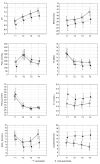Prognosis of Hypothermic Patients Undergoing ECLS Rewarming-Do Alterations in Biochemical Parameters Matter?
- PMID: 34574690
- PMCID: PMC8468166
- DOI: 10.3390/ijerph18189764
Prognosis of Hypothermic Patients Undergoing ECLS Rewarming-Do Alterations in Biochemical Parameters Matter?
Abstract
Background: While ECLS is a highly invasive procedure, the identification of patients with a potentially good prognosis is of high importance. The aim of this study was to analyse changes in the acid-base balance parameters and lactate kinetics during the early stages of ECLS rewarming to determine predictors of clinical outcome.
Methods: This single-centre retrospective study was conducted at the Severe Hypothermia Treatment Centre at John Paul II Hospital in Krakow, Poland. Patients ≥18 years old who had a core temperature (Tc) < 30 °C and were rewarmed with ECLS between December 2013 and August 2018 were included. Acid-base balance parameters were measured at ECLS implantation, at Tc 30 °C, and at 2 and 4 h after Tc 30 °C. The alteration in blood lactate kinetics was calculated as the percent change in serum lactate concentration relative to the baseline.
Results: We included 50 patients, of which 36 (72%) were in cardiac arrest. The mean age was 56 ± 15 years old, and the mean Tc was 24.5 ± 12.6 °C. Twenty-one patients (42%) died. Lactate concentrations in the survivors group were significantly lower than in the non-survivors at all time points. In the survivors group, the mean lactate concentration decreased -2.42 ± 4.49 mmol/L from time of ECLS implantation until 4 h after reaching Tc 30 °C, while in the non-survivors' group (p = 0.024), it increased 1.44 ± 6.41 mmol/L.
Conclusions: Our results indicate that high lactate concentration is associated with a poor prognosis for hypothermic patients undergoing ECLS rewarming. A decreased value of lactate kinetics at 4 h after reaching 30 °C is also associated with a poor prognosis.
Keywords: ECLS; accidental hypothermia; lactate; lactate kinetics; rewarming.
Conflict of interest statement
The authors declare no conflict of interest.
Figures


References
-
- Pasquier M., Hugli O., Paal P., Darocha T., Blancher M., Husby P., Silfvast T., Carron P.-N., Rousson V. Hypothermia outcome prediction after extracorporeal life support for hypothermic cardiac arrest patients: The HOPE score. Resuscitation. 2018;126:58–64. doi: 10.1016/j.resuscitation.2018.02.026. - DOI - PubMed
-
- Podsiadło P., Darocha T., Svendsen Ø.S., Kosiński S., Silfvast T., Blancher M., Sawamoto K., Pasquier M. Outcomes of patients suffering unwitnessed hypothermic cardiac arrest rewarmed with extracorporeal life support: A systematic review. Artif. Organs. 2021;45:222–229. doi: 10.1111/aor.13818. - DOI - PubMed
-
- Lott C., Truhlář A., Alfonzo A., Barelli A., González-Salvado V., Hinkelbein J., Nolan J.P., Paal P., Perkins G.D., Thies K.-C., et al. European Resuscitation Council Guidelines 2021: Cardiac arrest in special circumstances. Resuscitation. 2021;161:152–219. doi: 10.1016/j.resuscitation.2021.02.011. - DOI - PubMed
-
- Cheng R., Hachamovitch R., Kittleson M., Patel J., Arabia F., Moriguchi J., Esmailian F., Azarbal B. Complications of Extracorporeal Membrane Oxygenation for Treatment of Cardiogenic Shock and Cardiac Arrest: A Meta-Analysis of 1,866 Adult Patients. Ann. Thorac. Surg. 2014;97:610–616. doi: 10.1016/j.athoracsur.2013.09.008. - DOI - PubMed
Publication types
MeSH terms
Substances
LinkOut - more resources
Full Text Sources
Medical

